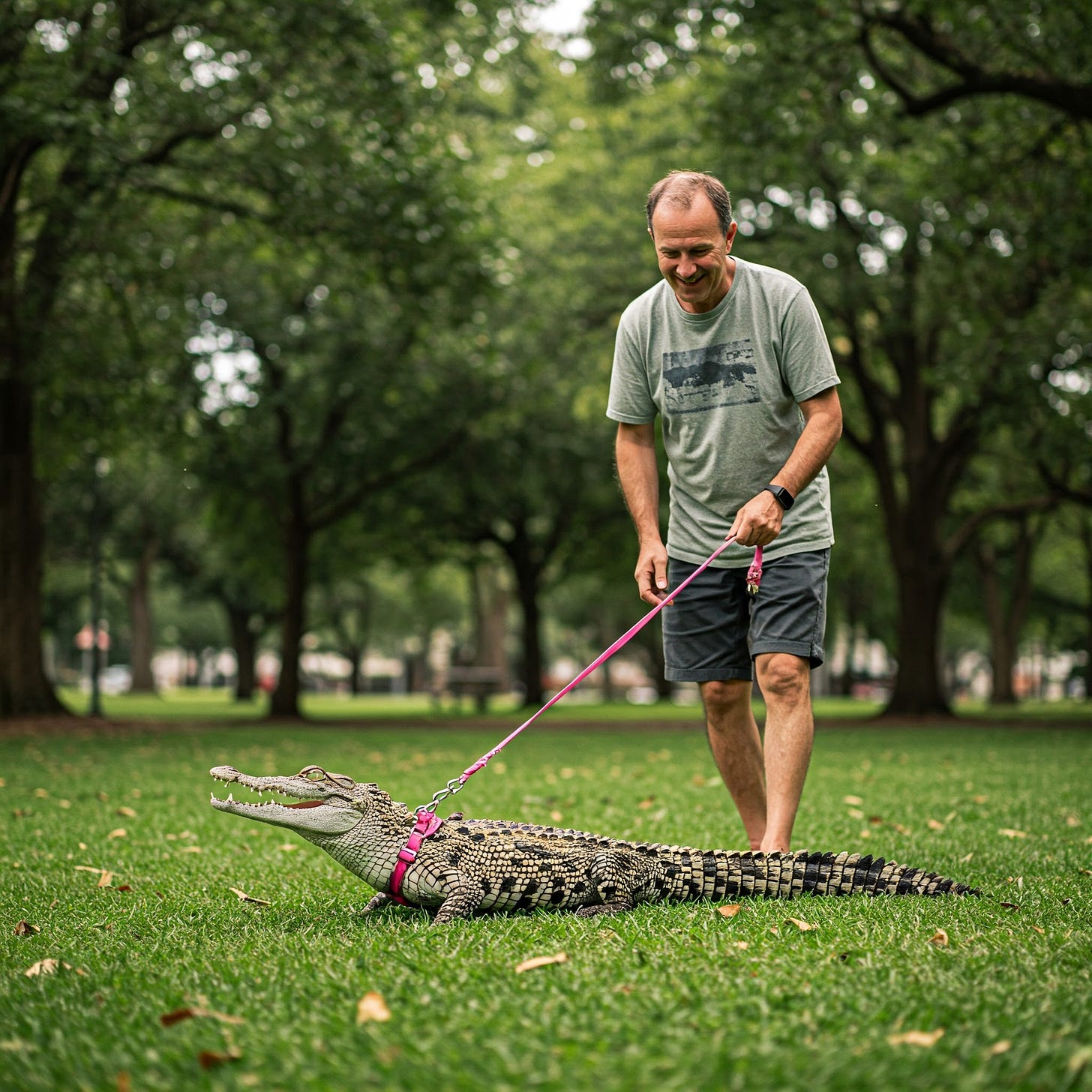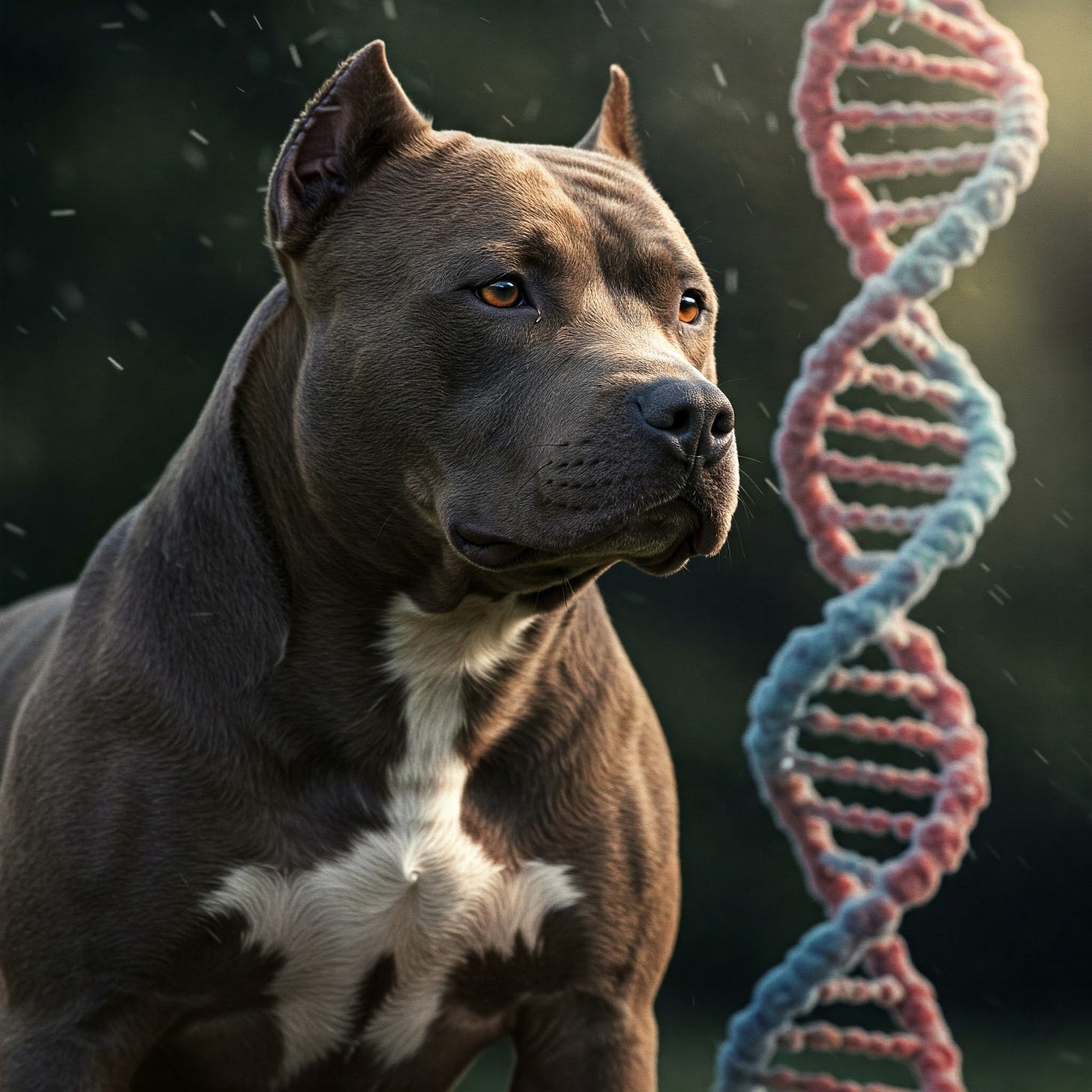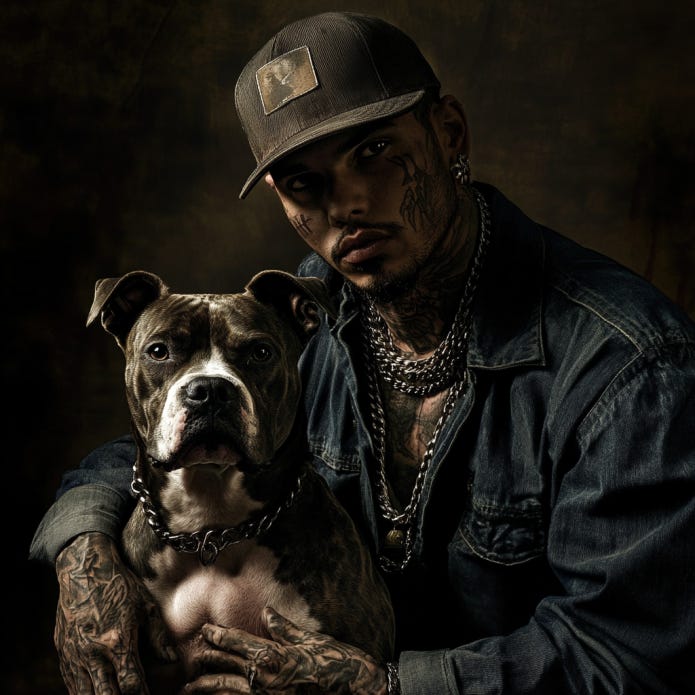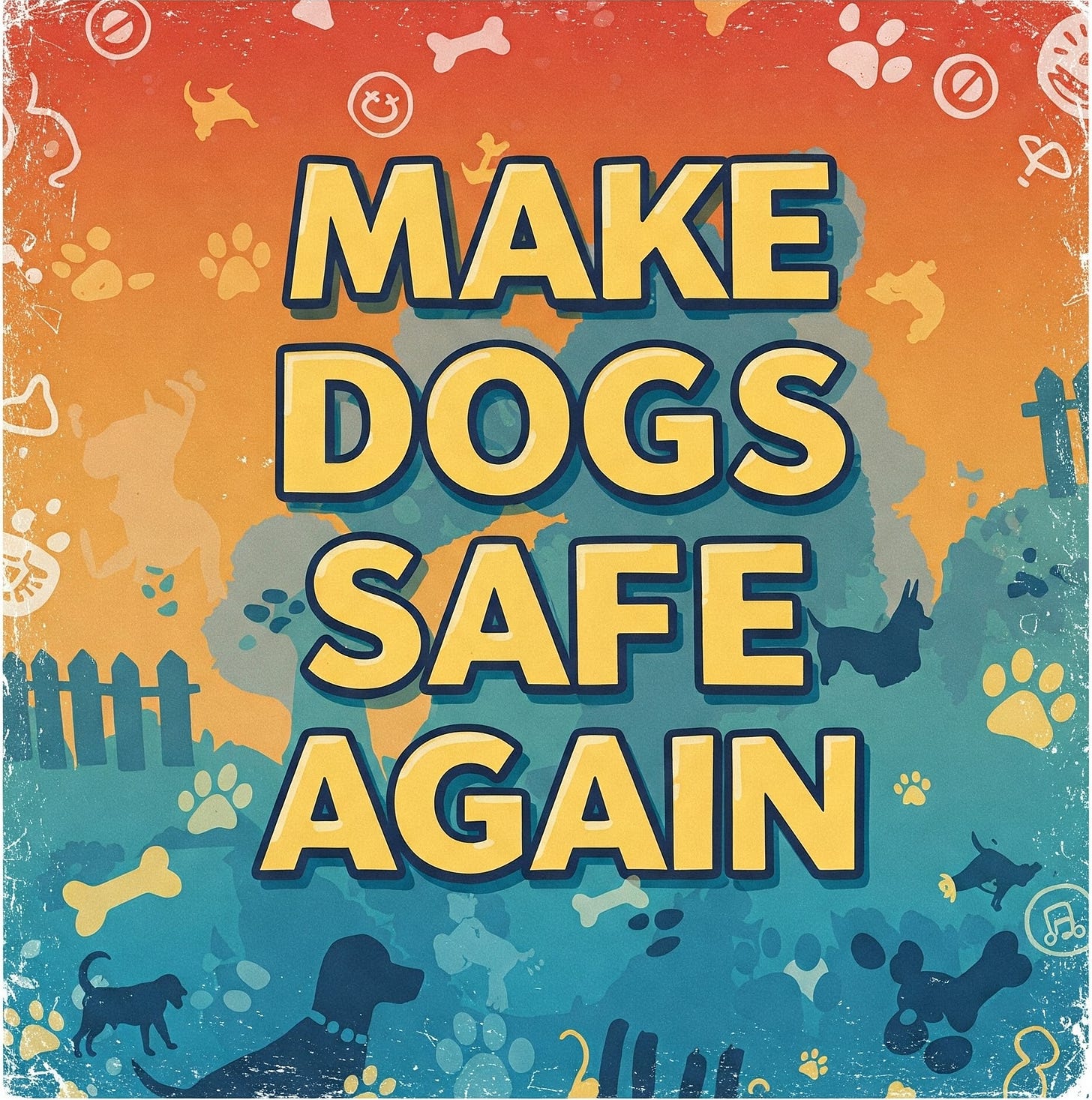Pit Bulls Should be Banned or Regulated the U.S. (2025) - Overpopulation, Genetics, Attack Data, Safety Risks
Pit Bulls are now ~20% (1/5) of all dogs in the U.S., yet the general public remains clueless about their lethality...
I don’t hate Pitbulls anymore than I hate crocodiles, sharks, hippos, lions, tigers, polar bears, pythons, etc., but none have any business being owned as pets or roaming around in public spaces.
And nobody (especially kids) should feel threatened, unsafe, on edge, or as though they’re “walking on eggshells” while strolling city/suburban neighborhoods or hiking trails.
As of 2025, there are an estimated 18 million Pitbull-type dogs in the United States—an umbrella term covering the American Pit Bull Terrier, American Staffordshire Terrier, Staffordshire Bull Terrier, American Bully, and a range of similar mixes.
This figure accounts for about 20% of the total dog population in the U.S. (1/5 dogs are Pits), up dramatically from ~5% just a few decades ago.
Rapid growth for the Pitbull population stems from a combo of: large litter sizes, widespread ownership, celebrity & shelter marketing campaigns to rescue, social media communities dedicated specifically to Pitbulls, and perhaps a decline in intelligence (i.e. Reverse Flynn Effect).
The only half-assed argument I’ve heard supporting the freedom to own Pits and Pit-mixes is that absolute number of human deaths per year from dog attacks in the U.S. is very low (~71 in 2024… and not all were from Pits but most were). (LINK)
But this is an extremely myopic view that fails to consider the full impact of Pits: serious injuries (e.g. survived but required medical care, reconstructive surgery, permanent damage, etc.), pet deaths, wildlife deaths/damage, ecosystem disruption, property damage, overloaded shelters (with high costs), and fear/behavioral changes in the country (walking different routes to avoid Pits).
If one were to quantify all the direct and indirect harms attributable to Pitbulls (and mixes)—medical costs, emotional trauma, lost productivity, property damage, wildlife depletion, and shelter burdens—the net societal toll would tower above that linked to any other dog breed.
This reality supports arguments for banning or heavily restricting Pitbull ownership (especially considering the rise in pet ownership in the U.S.).
Potential Approaches
Phasing Out the Breed: Gradual elimination could mean allowing currently owned Pitbulls to live out their natural lifespans while outlawing breeding and enforcing mandatory spay/neuter.
Severe Legal Consequences: A more controversial proposal suggests extreme penalties (e.g., the death penalty or lengthy prison terms) for owners whose Pitbulls kill or seriously injure another person or pet.
Accountability: At the very least, Pitbull owners shouldn’t get a free pass if their dog mauls a child, kills another pet, or sends a mail carrier to the ER. If owners truly believe Pitbulls are safe, they should have no issue accepting maximum liability.
The Crocodile (Wild Predator) Analogy
Pitbulls may share the same genetic family as other domestic dogs, but their selective breeding for combat places them genetically closer to a “wild predator” role than a domesticated pet.
Much like crocodiles, which can appear docile for long stretches, Pitbulls can suddenly and unpredictably unleash lethal aggression, often without any prior warning signals.
In short, no hatred is directed at the dogs themselves—just as one might not “hate” a crocodile. But Pitbulls’ inherent risks demand regulation, either by phasing them out or holding owners to strict standards with severe consequences for attacks.
ARCHIVE: Fatal Pit Bull Attacks in the U.S. (1833 to Present)
The Pitbull Population Boom in the U.S. (2025)
As of 2025, estimates place 18 million Pitbull-type dogs in the United States. This umbrella category includes the American Pit Bull Terrier, American Staffordshire Terrier, Staffordshire Bull Terrier, American Bully, and various mixes.
Together, they make up about 20% of the U.S. dog population—a steep rise from roughly 5% a few decades ago.
1 in 5 dogs in the U.S. is now classified as a Pitbull or Pit-mix.
This rapid climb dovetails with an uptick in neighborhood unease, as more people encounter Pitbulls on walks, in apartment buildings, and along hiking trails.
Factors Fueling Growth
Large Litter Sizes
Compared to common pet breeds producing 5–6 puppies per litter, Pitbulls often yield 8–12. (LINK)
Each unspayed female Pitbull can produce numerous large litters, compounding overpopulation.
Shelter & Social Media Marketing
“No-kill” movements and rescue campaigns frequently spotlight Pitbulls as “misunderstood,” urging adoptions with little mention of breed-specific aggression.
Celebrity endorsements and online communities paint Pitbulls as lovable underdogs, downplaying or ignoring attack data.
Irresponsible Ownership
A higher proportion of Pitbull owners, relative to other breed owners, exhibit antisocial tendencies (e.g., criminal histories or dogfighting involvement). (Ragatz et al., 2009)
These owners are less likely to spay/neuter, more likely to keep dogs in poor conditions, and more prone to abandoning unwanted litters.
Pandemic Spike
During COVID-19, many people impulsively adopted dogs, including Pitbulls, without proper training or containment plans.
Consequently, shelters saw a surge in returns when owners realized they couldn’t handle the responsibility.
Community Impact
Heightened Public Anxiety: With Pitbull populations rising, neighborhoods and outdoor recreation areas report increased fear and avoidance behaviors.
Animal Control Strain: Feral or abandoned Pitbulls form roaming packs in some urban or semi-rural settings, demanding more frequent (and dangerous) sweeps by animal control.
Shelter Overcrowding: Many facilities devote disproportionate resources to housing and attempting to rehome Pitbull-types. Their size, potential aggression, and stigma often lengthen shelter stays.
Taken together, these dynamics create a feedback loop: more Pitbulls lead to more attacks, higher shelter intakes, and heavier societal costs. With little to no regulatory framework in most regions, there’s no natural ceiling to Pitbull population growth—further escalating the public safety risk.
The Vicious Cycle: Pitbull Population Explosion (U.S.)
A unique convergence of factors has led to Pitbulls becoming one-fifth of all dogs in the U.S.
Irresponsible or “Low-Life” Owners: Owners who engage in criminal activities or exhibit antisocial behavior (e.g., drug dealers, gang members) often refuse to spay or neuter Pitbulls. They see no need—or even prefer—large litters for breeding, dogfighting, or intimidation purposes.
Excessive Breeding & Large Litters: Pitbulls commonly produce 8–12 puppies per litter, surpassing the 5–6 typical of other large breeds. In combination with the owners’ reluctance to sterilize, these big litters rapidly flood neighborhoods and shelters.
Easy Access for “Do-Gooders” & Low-Income Adopters
Well-Meaning Rescuers: Shelters and rescue groups encourage people to adopt Pitbulls to “save them,” often with little warning about the dogs’ genetic background or potential aggression.
Free or Cheap to Acquire: Pitbull puppies in low-income areas may be given away at no cost, drawing economically disadvantaged adopters who may lack resources for proper training or veterinary care.
Shelter Overcrowding, “No Kill,” & Re-Abandonment: When novices or unprepared owners realize the challenges (strength, aggression, size, upkeep), many Pitbulls are surrendered back to shelters—or simply abandoned—further reinforcing high intake numbers. There is also strong pressure to never euthanize (“no kill” laws).
Repeat of the Cycle: With each wave of puppies, more unsterilized dogs proliferate. Shelters scramble to place them—often mislabeling or pushing emotional “rescue” narratives—leading to more adoptions by well-intentioned but underprepared individuals. Ultimately, the problem continues snowballing.
Result: Pitbulls grow from a niche fighting breed to 20% of the national dog population in mere decades, saturating shelters, straining public safety services, and fueling higher rates of severe attacks—unless bold measures (strict spay/neuter policies, ownership restrictions, or bans) break the cycle.
Pitbulls: Attack Data & Severity

Rising Fatalities
Over the last 15 to 20 years, the United States has seen a jump in dog bite-related fatalities, from around 40 per year pre-2010 to roughly 100 in post-COVID data. (LINK)
Pitbulls Dominate Fatal Attacks: Even when Pitbulls comprised only about 8% of the dog population, they were responsible for approximately 69% of fatal dog bites in 2019.
Long-Term Trend (2005–2019): Pitbulls accounted for 66.4% of all recorded dog bite fatalities (346 deaths), far outpacing the second-most lethal breed, Rottweilers, at about 9.8% (51 deaths). (LINK)
Likely Underreported: Many incidents involving “mixed breeds” may include partial Pitbull ancestry, pushing the true figure for Pitbull-involved fatalities closer to 75% or higher.
Historically Consistent (1979-1988):
JAMA reported (Sacks et al., 1989) that 157 dog bite-related fatalities occurred in the U.S. from 1979-1988 and Pitbull breeds were involved in 41.6% where the breed was reported (~3x the next reported breed).
This historic data indicates that Pitbulls were the most lethal breed of dog in the 1970s/1980s of dog bite attacks… which is consistent with what we observe in the present era.
Comparisons to Other Breeds:
Rottweilers and German Shepherds follow behind (each under 10%), highlighting the massive disparity in lethal outcomes favoring Pitbulls.
Severe Injuries & Medical Consequences
Pitbulls also drive a disproportionate share of the most severe, life-altering injuries:
Reconstructive Surgeries:
Hospitals consistently report that Pitbull-related bites involve more extensive tissue damage—often requiring specialized reconstructive or plastic surgery.
A peer-reviewed paper by Bailey et al. (2019) documented that Pitbulls accounted for a disproportionate number of severe dog bite injuries in the U.S. from 1971-2018. (LINK)
Complex Reconstructive Surgeries:
A Mexican Medical Journal (Chavez-Serna et al., 2019) emphasized that Pitbull-inflicted wounds often require more extensive surgical intervention than other dog attacks.
The International Journal of Pediatric Otorhinolaryngology (Essig Jr. et al., 2019) noted that injuries from Pitbulls and mixed breed dogs were the most frequent and severe in bite injuries to the face.
The Journal of Oral Maxillofacial Surgery (Khan et al., 2020) documented a trend toward more severe dog-bite injuries in young children with Pitbull Terriers being the most complex wounds. (Most of the attacks were completely unprovoked).
Children at Greatest Risk:
The International Journal of Pediatric Otorhinolaryngology (Bini et al., 2011) revealed that Pitbulls are disproportionately implicated in severe bite incidents requiring pediatric hospitalization. Facial bites, neck injuries, and permanent disfigurement frequently result.
The Annals of Plastic Surgery (Reuter Munoz et al., 2021) emphasized that Pit bull or pit bull mix were the most common offending breed for pediatric dog bites at a Level 1 Trauma Center.
Emergency Room Visits & Long-Term Care
4.5 million dog bites occur annually in the U.S., with 800,000 requiring medical attention (CDC). Pitbulls are tied to a large fraction of the most serious cases.
Survivors often undergo multiple procedures and suffer long recoveries, lost wages, and psychological trauma (PTSD, anxiety).
Attacks on Pets & Wildlife
Pitbulls’ high prey drive and tenacity also yield significant animal-on-animal aggression:
2019 Data suggests Pitbulls were involved in 91% of fatal attacks on other animals, including dogs, cats, and livestock - slaughtering an estimated 38,000 animals that year.
Thanks to their “hold-and-shake” style and powerful jaws, Pitbulls can kill or gravely injure other animals before intervention is even possible.
According to the American Veterinary Medical Association (AVMA, 2018), they are heavily overrepresented in fatal dog-on-dog attacks and kills on cats or livestock.
Public Spaces:
Off-leash parks or neighborhoods can turn deadly when a powerful Pitbull fixates on another dog or a small pet.
Owners frequently underestimate their Pitbull’s aggression toward unfamiliar animals, with attacks happening “out of nowhere.”
Economic & Social Costs
Beyond the human toll, each severe attack generates tens of thousands of dollars in medical bills, legal fees, and insurance claims. Communities also shoulder the cost of:
Animal Control efforts to contain roaming or feral Pitbulls.
Shelter Overcrowding, as Pitbulls make up a large percentage of long-term canine residents.
Avoidance Behaviors: People may avoid certain neighborhoods, sidewalks, or parks, undermining quality of life.
Medical Bills:
The average dog bite hospitalization is $18,200, and Pitbull attacks often exceed this due to surgical complexity.
Lawsuits & Insurance Claims:
Homeowner insurance claims for dog bites cost hundreds of millions annually (Insurance Information Institute).
The average cost per claim has increased by 82.5% from 2014-2023. (LINK)
Many insurers either charge higher premiums for Pitbull owners or exclude coverage altogether.
Shelter Burden:
Pitbulls are frequently the longest-staying, hardest-to-adopt dogs in shelters. Their size and potential aggression lead to increased resource usage (food, space, staff).
Taxpayers or donors bear the financial strain when shelters become overrun with Pitbull intakes.
Lost Productivity & Mental Health Costs:
Attack survivors often suffer from PTSD, depression, and anxiety, impacting their ability to work.
Family members may require time off for caregiving or court proceedings, further compounding financial stress.
In short, the societal burden of Pitbull attacks encompasses far more than the annual fatality count. It includes life-altering injuries, fear-induced changes in behavior, property and livestock damage, and staggering financial repercussions.
Feral Pitbulls
Abandonment and low spay/neuter rates can result in feral Pitbull packs in some urban or semi-rural areas. Although this isn’t very common, we should consider that they:
Target Livestock and Pets: Farmers report livestock losses, and neighborhoods see an uptick in missing cats or small dogs.
Are Resource-Intensive: Animal control must perform repeated sweeps, costing local governments substantial funds.
Put Humans At Risk: Feral packs are less socialized and can be more unpredictable, sometimes attacking joggers or children playing outdoors.
Collectively, these data points underscore that Pitbull-related incidents aren’t just “random unfortunate events.”
Rather, they reflect an ongoing escalation in the frequency of vicious attacks, placing public health and safety at significant risk.
Note: Many have had to alter behaviors (e.g. avoid walking certain streets, visiting certain areas, etc.) because Pitbulls are nearby. Without the intentional avoidance of Pitbulls, injuries/deaths would likely be higher.
Evolutionary & Behavioral Genetics of Pitbulls
A.) Bloodsport Origins
Pitbulls descend from bulldog–terrier crosses designed specifically for bull-baiting—a spectacle in which dogs clamped onto a tethered bull’s snout until the bull collapsed or was severely injured (Scott & Fuller, 1965).
When bull-baiting fell out of favor and was eventually outlawed in the 19th century, breeders switched to dogfighting, further honing traits such as “gameness” (the refusal to quit even when gravely hurt).
Bull-Baiting: This practice encouraged dogs to latch onto large animals despite immense risk, effectively selecting for dogs that tolerated pain well and persevered under distress.
Dogfighting Transition: Once bull-baiting became illegal, underground dogfighting rings preferred dogs that would continue attacking despite injuries, reinforcing the already high threshold for pain and aggression (Duffy et al., 2008).
B.) Physical Power & Behavioral Aggression
Pitbulls exhibit several traits making them uniquely dangerous compared to other breeds:
Jaw Strength (~230-300+ PSI): Multiple sources show Pitbull bite force surpasses that of an average dog (150–200 PSI). This powerful grip is pivotal in “hold-and-shake” attacks. (LINK)
High Pain Tolerance: Bred into them over generations, Pitbulls can endure injuries that would deter other dogs, allowing them to continue mauling when a typical dog might back off.
Stocky, Muscular Build: Compact, powerful frames enable them to lunge forcefully and maintain a lethal hold.
Selective Aggression: Centuries of bloodsport breeding favored dogs that showed heightened aggression toward both animals and humans when “triggered.”
Why Genetics Matter More Than Environment…
While training and socialization are crucial, they cannot fully override hundreds of years of selective breeding.
While it’s true that any dog can exhibit aggression under poor conditions, breed-specific traits are heavily influenced by genetics.
Scott & Fuller (1965) emphasized how selective breeding can shape a dog’s behavior far more than environment alone. (LINK)
Duffy et al. (2008) found that breed differences in aggression persist even when controlling for owner behavior and training styles. (LINK)
Minor variations in breed-specific genes can magnify aggression, rendering the “99% genetic similarity to other dogs” argument moot—it’s the 1% that’s lethal.
Myth of the “Nanny Dog”
One of the most pervasive myths about Pitbulls is that they were once known as “nanny dogs,” supposedly caring for children.
In reality, ZERO historical evidence supports this claim. The term only appeared in modern promotional campaigns aimed at rehabilitating the breed’s image (often in the 1970s).
Their actual documented history centers on bull-baiting, dogfighting, and contests of raw aggression—not babysitting children. Proponents of this myth basically cherrypick vintage photos with kids around Pitbull-type dogs as “proof” that this scenario was common. (LINK)
Real-World Implications
Pitbulls can seem gentle or docile for years but still “snap” due to a trigger that activates underlying aggression:
Sudden Turn: Countless attack reports note Pitbulls that showed no prior signs of violence before a severe mauling.
Unpredictable Stimuli: Fast movements, other animals, or even high-pitched sounds from children may ignite a fight response that was genetically cultivated over centuries.
Thus, no amount of social media rebranding changes the breed’s entrenched capability for catastrophic damage. This biologically rooted threat underscores why many experts argue for special regulations or outright bans targeting Pitbull-type breeds.
The Pitbull Shelter Crisis & Mislabeling
Shelters across the United States frequently report that Pitbull-type dogs make up a significant—often 50% or more—portion of their canine population. This is partly due to:
High Intake
Owners abandon Pitbulls at elevated rates compared to many other breeds, whether because the dogs display aggression, become too large, or demand more resources than anticipated.
Uncontrolled Breeding: Pitbulls typically have 8–12 puppies per litter, increasing the likelihood of overpopulation.
Longer Stays & Overcrowding
Pitbulls are difficult to adopt out due to public perception (both stigma and factual concerns about aggression).
Many remain in shelters for months—or sometimes indefinitely in “no-kill” facilities—placing a disproportionate strain on kennel space, staff time, and budgets.
The “No-Kill” Pressure
The movement toward “no-kill” shelter policies, while well-intentioned, often results in aggressive or unadoptable Pitbulls being housed for prolonged periods:
Resource Drain: Larger dogs require more food and kennel space. Pitbulls prone to aggression may need special handling, training, or isolation from other animals, using up staff and volunteer hours that could benefit other homeless pets.
High-Cost Upkeep: Medical care, spay/neuter operations, and day-to-day maintenance mount quickly, especially when the dogs in question have fewer potential adopters.
Mislabeling & Emotional Marketing
To lower euthanasia rates and improve adoption chances, shelters sometimes mislabel Pitbulls as “Boxer mixes,” “Lab mixes,” or generic “terrier mixes.” While motivated by a desire to save lives, this practice:
Destabilizes Data: It becomes harder to accurately track Pitbull attack rates if they’re systematically mislabeled on paperwork or official records.
Potentially Endangers Families: Naive adopters may bring home a dog with undisclosed fighting ancestry, clueless about the specific handling and containment practices a Pitbull might require.
Emotional Narratives: Some shelters focus on rescue stories—“this dog was abused, deserves a second chance”—while downplaying or ignoring genetic aggression. Many adopters remain unaware of the breed’s original bloodsport purpose or the heightened risk of severe attacks.
Cycle of Returns & Euthanasia
Well-intentioned adopters sometimes discover they cannot control or properly manage their Pitbull, leading to returns or re-abandonment. The dog re-enters the shelter system, further inflating occupancy and costs:
Behavioral Deterioration: Prolonged shelter stays can worsen a dog’s stress and aggression, making re-adoption even less likely.
Repeat Expenses: Each return triggers repeated medical exams, vaccines, and overhead costs, making Pitbulls a financial sinkhole for underfunded shelters.
Overall, the shelter crisis around Pitbulls intertwines with public safety concerns, as the drive to adopt them out (often via misleading practices) disperses high-risk dogs into unprepared households or neighborhoods.
Pitbull Owner Archetypes & Irresponsibility
1. Criminals, Gangs, Psychopaths
Certain Pitbull owners align with antisocial or criminal profiles—including drug dealers, gang members, or dogfighters. (Barnes et al., 2006) (Ragatz et al., 2009)
Pitbulls frequently serve as status symbols for these types. Their intimidating appearance and entrenched aggressiveness can be exploited as a weapon.
Moreover, illegal dogfighting rings rely heavily on Pitbulls, further entrenching their use among antisocial elements.
Intimidation Factor: Pitbulls project toughness and serve as a deterrent.
Dogfighting Exploitation: Pitbulls’ fighting lineage makes them prime candidates for illegal gambling events.
Neglect or Abuse: Such owners often fail to vaccinate, spay/neuter, or train their dogs responsibly, heightening the likelihood of attacks.
Note: By “antisocial” we mean the psychiatric definition (not “doesn’t socialize much”)… psychiatrically, antisocial refers to: aggression towards people/animals, destruction of property, lying/dishonesty, theft, serious violation of rules. (LINK)
2. Attention-Seekers & Macho Persona
Some owners simply want a “tough” or “cool” dog to boost their aesthetic or to get attention:
Rebellious Branding: A strong, intimidating breed can feed a sense of personal edginess or perceived invincibility.
Poor Containment: These individuals often lack the patience or skill to manage a powerful, willful breed, increasing danger to the public.
3. Bleeding-Heart “Rescuers”
On the opposite end are highly empathetic but misguided owners:
Shelter Narratives: They adopt Pitbulls from emotional pleas (“save a life,” “end breed discrimination”), believing love alone can mitigate genetic aggression.
Lack of Readiness: Many are unprepared for the strength, stamina, or potentially volatile behavior of a Pitbull, especially around children or other pets.
4. Singles (Often Women) Seeking Company & Security
Some single adults, looking for companionship and protection, assume a Pitbull will serve as both a loyal pet and a guard dog.
They may discount the breed’s historical aggression or buy into:
“It’s All in How They’re Raised”: A pitfall that overlooks the influence of inherited fighting traits.
False Sense of Security: Believing in a protective companion can mask the latent risk until it’s too late.
5. Cultural & Economic Factors (Including Illegal Immigrants, Cartels)
In some communities, Pitbulls are used for cheap guard dogs or status symbols, with minimal veterinary care or spay/neuter. Others simply are uneducated and/or fail to understand the full scope of danger these dogs pose.
What often ends up happening?
Abandonment: Dogs may be released onto the streets, forming feral packs that threaten local pets and occasionally people.
Rapid Breeding: Unsterilized animals produce large litters, perpetuating the cycle of overpopulation and high shelter intakes.
Minimal Care: These owners often fail to provide proper veterinary attention, vaccinations, or sterilization.
A Universal Thread: Irresponsibility & Naïveté
Not every Pitbull owner is an irresponsible criminal, but the breed’s powerful build, historical purpose, and intense loyalty can magnify negative outcomes when poorly managed or misunderstood.
Even well-meaning owners can fall prey to myths (“nanny dog,” “it’s just how you raise them”) and fail to take sufficient precautions (secure enclosures, strong leashes, muzzles, high fences).
Ultimately, the intersection of a fighting-dog lineage with large-scale owner mismanagement proves central to why Pitbulls are overrepresented in severe attacks, fatalities, and shelter populations.
Common Pro-Pitbull Arguments Debunked
1. “All Breeds Can Bite”
Counterpoint: True—any dog can bite. But not all dogs inflict catastrophic or fatal injuries at the same rate. Pitbulls are overrepresented in lethal and severe maulings, far exceeding what would be expected from their population share.
Severity Over Frequency: Small dogs like Chihuahuas may bite more often, but their bites almost never result in the same medical devastation or fatalities.
Data-Driven Reality: Pitbulls account for approximately 66–70% of dog bite-related deaths, making them the clear leader in serious, disfiguring attacks.
2. “It’s All in How They’re Raised”
Counterpoint: Environment and training matter, but genetics set a baseline. No amount of good ownership fully negates the inherited traits from centuries of bull-baiting and dogfighting.
Research Evidence: Studies (Scott and Fuller 1965, Duffy et al. 2008) underscore that breed-specific aggression persists across varied rearing conditions.
Instinct Override: Even well-cared-for Pitbulls with no prior incidents have “snapped” when triggered—something rarely seen in breeds without a bloodsport lineage.
3. “My Pitbull Has Never Shown Aggression”
Counterpoint: A lack of aggression so far does not guarantee future safety. Many serious Pitbull attacks are described by owners as “out of the blue.”
Dormant Genes: A dog’s fighting instincts may remain hidden until an unexpected stimulus (running children, another pet, perceived threat) flips that switch.
Unpredictability: The breed’s high pain tolerance and “hold-and-shake” bite style can turn a fleeting moment of aggression into a lethal event in seconds.
4. “Chihuahuas Bite More Often Than Pitbulls”
Counterpoint: Chihuahuas—and other small dogs—may nip frequently, but their bites are almost never fatal. Pitbull bites, on the other hand, cause severe disfigurement or death far more often than smaller breeds.
Lethal Potential: A Chihuahua’s jaws and body mass can’t rival a Pitbull’s 230–300+ PSI bite force or the breed’s fighting tenacity.
Hospital Data: Pitbull attacks disproportionately end in reconstructive surgery or extended ICU stays, whereas smaller dog bites rarely reach that threshold.
5. “Nanny Dog” Myth
Counterpoint: No historical or breed-standard documentation supports the idea that Pitbulls were originally “nanny dogs.” This story emerged in modern marketing to counter the breed’s dogfighting stigma.
Actual Heritage: The known history revolves around bull-baiting and underground dogfights, not child-rearing.
False Security: Families believing the nanny-dog myth may leave children alone with a Pitbull, sometimes with tragic outcomes.
6. “If Guns Are Legal, Pitbulls Should Be Too”
Counterpoint: A firearm cannot load or fire itself; a Pitbull—like any living creature—acts autonomously, sometimes unpredictably.
Mobility & Autonomy: A gun stays where you put it, whereas a Pitbull can scale fences, escape leashes, and launch attacks without a human actively directing it.
Storage vs. Roaming: Guns must be locked away or carried responsibly. Pitbulls can—and often do—roam freely, posing a continuous potential threat.
7. “They’re So Intelligent—It’s Easy to Train Them”
Counterpoint: While some Pitbulls learn commands quickly, intelligence doesn’t neutralize deeply ingrained fighting instincts.
Instinct vs. Training: Under stress, the breed’s hardwired aggression can override learned behaviors—especially in an intense confrontation with another animal or an unrecognized human threat.
Cunning Can Escalate Risk: A strong, determined, and potentially clever dog can escape enclosures or manipulate situations, leading to uncontrolled attacks.
Despite claims of superior intelligence, law enforcement officers and military agencies overwhelmingly use other breeds in the field (German Shepherds, Belgian Malinois, or Labradors) for tasks like detection, search-and-rescue, or suspect apprehension due to consistent predictable responses under stress.
In short, these common defenses fail to address the core reality: Pitbulls were specifically bred for lethal combat. They can be calm and lovable—but only until something triggers their evolutionary instincts. The data consistently shows a higher likelihood of catastrophic outcomes with Pitbulls compared to virtually any other breed.
Proposed Solutions to the Pitbull Problem in the United States (U.S.)
Option 1: Gradual Phase-Out (Mandatory Spay/Neuter)
Rationale: By restricting Pitbull breeding and ensuring all existing dogs are sterilized, the population would decline naturally over time.
Implementation: Ban new Pitbull sales or adoptions, enforce mandatory spay/neuter, and allow current Pitbulls to remain until the end of their natural lifespan—provided owners meet safety requirements.
Option 2: Special Permits & High-Stakes Liability
Permit System: Potential Pitbull owners must pass a psychiatric evaluation, demonstrate secure fencing, and obtain specialized insurance to cover damages if an attack occurs.
Financial Accountability: Substantial insurance premiums or cash bonds (like $50,000 or more) could deter impulsive or unprepared ownership.
Public Safety: Owners who truly insist Pitbulls pose “no danger” should feel comfortable with stringent oversight if they’re confident their dog won’t harm anyone.
Option 3: Death Penalty to Owners for Serious Attacks
Severe Charges: If a Pitbull kills or causes catastrophic injury, the owner faces murder charges and the death penalty for allowing a “deadly weapon” to roam freely (assuming not self-defense).
Zero Tolerance: Dogs that maim or kill are immediately euthanized; owners could also lose the right to own dogs in the future.
Deterrent Effect: Knowing you could face life-altering legal consequences—or even the death penalty in extreme jurisdictions—discourages casual or negligent Pitbull ownership.
Option 4: Mandatory Insurance or Large Deposits
High Premiums: Insurance companies often deny or inflate premiums for Pitbulls. Making substantial coverage mandatory ensures victims of attacks have recourse.
Owner Vetting: Premium cost alone can deter irresponsible or financially unstable owners, reducing the likelihood of unconfined or poorly trained Pitbulls.
Option 5: National Ban on Pitbulls and Pit-Mixes
Full Prohibition: Outright ban the ownership, breeding, or import of Pitbull-types. Confiscate and euthanize any newly discovered or illegally possessed Pitbulls.
Legal Precedents: Some countries (like the UK under the Dangerous Dogs Act) and specific US municipalities have successfully enforced breed-specific legislation targeting Pitbulls.
Community Impact: This eliminates the breed’s public safety crisis, albeit with controversy and backlash from advocacy groups.
Balancing Freedom & Public Safety
Pitbull advocates often argue for “freedom of choice,” yet public safety must come first. Society already restricts or bans items deemed highly dangerous (e.g., certain firearms, explosives, exotic animals).
Given Pitbulls’ disproportionate role in severe attacks, many believe that strong policies are both justified and necessary.
“Owners Shouldn’t Get to Have Their Cake and Eat It Too”
If one chooses to keep a genetically aggressive breed capable of maiming or killing, that individual should also face uncompromising accountability for the consequences.
From harsh criminal penalties to expensive insurance mandates, these measures reflect the reality that Pitbulls aren’t just any pet—they can be, in effect, domestic predators.
Global & Local Precedents for Pitbulls
United Kingdom: Dangerous Dogs Act (1991)
The UK’s Dangerous Dogs Act targeted four breeds, including Pitbulls, banning their ownership, breeding, sale, and exchange without specific exemptions.
Since 2023, the UK has also announced a ban on the “XL bully” variant, making it illegal to sell, breed, or abandon this Pitbull-type dog. Although controversial among dog lovers:
Fatal Attacks Decline: After initial enforcement, the UK experienced a drop in Pitbull-related fatalities.
Enforcement Challenges: Some critics argue the Act can be circumvented through mislabeling or by crossing banned breeds with others, diluting the legislation’s effectiveness.
Reduced Visibility: Pitbulls are less commonly seen in public, reducing the likelihood of random attacks.
Australia: State-Level Restrictions
Multiple Australian states impose restrictions on Pitbull ownership:
Import Ban: Federally, Pitbulls cannot be imported.
Mandatory Sterilization: Existing Pitbulls often must be spayed/neutered, microchipped, and kept in secured enclosures.
Limited Success: While some areas have seen fewer Pitbull maulings, critics point to inconsistent local enforcement and continuing underground breeding as challenges.
U.S. Municipal & Housing Bans
In parts of the United States, local jurisdictions—cities, counties, or housing authorities—have enacted breed-specific legislation (BSL) targeting Pitbulls:
Complete Bans: Some municipalities prohibit Pitbulls outright, empowering animal control to confiscate and euthanize unregistered or newly acquired dogs.
Restricted Ownership: Others require owners to maintain costly insurance, muzzle the dog in public, or comply with strict containment rules (fenced yards meeting specific height/structure standards).
Apartment Complexes & HOAs: Many have “no Pitbull” policies to avert liability and neighbor disputes.
Factors Influencing Success
Strict Enforcement: Bans or restrictions that are well-enforced (microchip scans, breeder inspections, robust animal control funding) typically see reduced mauling incidents.
Public Support: Legislation gains traction if local communities witness repeated Pitbull attacks. Residents then become more inclined to prioritize public safety over the breed’s “right” to exist without regulation.
Consistency Across Regions: Breed bans can fail if neighboring areas do not follow suit, allowing owners to move or travel with Pitbulls across jurisdictional lines.
Controversies & Opposition
“Punish the Deed, Not the Breed”: Critics of BSL argue that laws should target irresponsible owners rather than entire breeds.
Shelter Overload & Euthanasia: When bans roll out rapidly, many Pitbulls are surrendered to shelters, which may be forced to euthanize them en masse due to limited resources.
Misidentification: In jurisdictions lacking thorough breed identification protocols, non-Pitbull dogs with similar appearances may be wrongfully targeted.
Despite these debates, ongoing data indicates that well-structured and rigorously enforced Pitbull restrictions can significantly reduce severe dog bite incidents and related fatalities.
“Make Dogs Safe Again” in the U.S. - Reduce Pitbulls
Pitbulls occupy a unique niche in the canine world: genetically programmed through centuries of bull-baiting and dogfighting to bite, hold, and shake with lethal force.
The average owner (perhaps drawn in by rescue campaigns or a tough-dog persona) rarely grasps the level of hyper-vigilance and containment these dogs require.
Coupled with widespread irresponsible breeding, skyrocketing shelter populations, and shelter mislabeling, the result is escalating attacks on humans, pets, and wildlife.
Why a Reduction Makes Sense
Fewer Pitbulls = Fewer Maulings: A straightforward correlation emerges: when a high-risk breed dwindles in numbers, the total severe attack rate falls.
Shelter Relief: Restricting or gradually phasing out Pitbulls eases overcrowding, reduces euthanasia rates (for other breeds), and lets shelters allocate more resources to genuinely adoptable, lower-risk dogs.
Public Safety Enhancement: Neighbors, mail carriers, and children walking to school can enjoy peace of mind without constantly worrying about whether a Pitbull is roaming off-leash nearby.
Compassion vs. Reality
Liking dogs—or even caring about Pitbulls themselves—doesn’t negate the breed’s lethal potential.
Many Pitbulls suffer due to neglect, abuse, and abandonment, but allowing the status quo perpetuates this cycle. A phased ban or tight restrictions could:
Prevent Future Maulings and unnecessary canine suffering in shelters.
Address the root issue of overbreeding and irresponsible ownership, rather than repeatedly cleaning up after brutal attacks.
Owners Shouldn’t Get to “Have Their Cake and Eat It Too”
Those who insist on keeping or breeding Pitbulls should face extreme accountability:
High-Stakes Liability: If your Pitbull kills or seriously injures someone, you face the death penalty immediately.
Mandatory Insurance & Containment: At minimum, owners should carry significant liability insurance and maintain secure enclosures.
Immediate Euthanasia of Offending Dogs: A Pitbull that violently attacks shouldn’t be shuffled to another home or “rehabilitated.” Public safety demands swift action.
Do I Hate Pitbulls? A Nuanced Perspective
I don’t like seeing them as pets, but I don’t hate them anymore than I’d hate a random crocodile… it’s not their fault they “exist.”
Lax policy in favor of “freedom” here isn’t a great idea (there are already laws in place to prevent ownership of exotic pets and in some communities vicious dogs)… would you be okay with your neighbor having a pet python, crocodile or lion? Probably not.
A majority of the general public is simply unaware (ignorance is bliss) of the feedback loop in place triggering the Pitbull population explosion - and they are simultaneously unaware of the outsized danger this breed poses to society as a result of genetic wiring.
Most sensible people would prefer walking in public spaces without seeing dogs that have potential to “snap” and kill on a whim. It’s difficult for adults to defend themselves against a Pit without a weapon - kids stand zero chance.
There is a reasonable case to be made that skilled trainers and/or people who prove they can handle Pitbulls safely (with high-level certifications - not just some BS certificate) should be able to own them and/or use them as guard dogs… but the general population? Not a great idea.
The average purple-haired, tatted-to-the-gills, communist-enthusiast letting their Pits roam around without a leash (“OMG he’s so friendly”) while they kill a few small dogs/cats in the neighborhood, gnaw off a couple delivery drivers’ kneecaps, and maim some random hikers - is what we need to avoid.
Yes Pitbulls were selectively bred for fighting, resulting in a genetic predisposition to behave aggressively and attack at any given moment. This means a Pitbull might seem completely friendly until one random thing “trips its trigger” (typical owner response: “I never saw it coming”).
Many who have compassion for Pitbulls lack compassion for humans and/or other pets… and they ignore the outsized dangers/costs levied upon society by the rapidly growing Pitbull population.
The smartest thing for the U.S. is a strategic reduction of the Pitbull population… in the long-run this would be a win-win: (1) less suffering/harm for Pitbulls (fewer of them around to suffer) AND (2) safer communities throughout the U.S.














